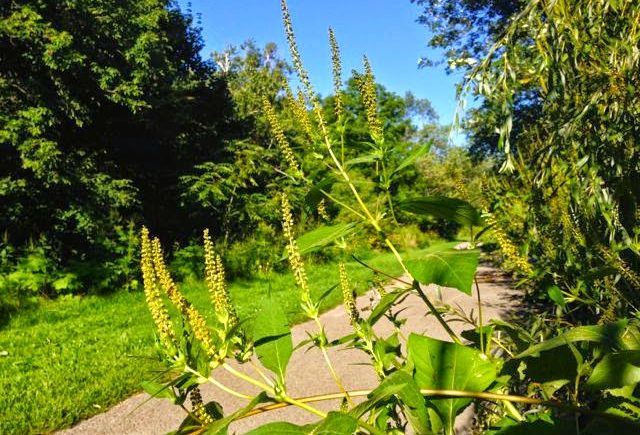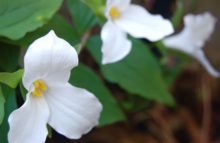| These are the insignificant-looking flowers that cause so much misery in late-summer hay-fever season |
You’re probably blaming the wrong guy. The culprits behind all that sneezing aren’t those pretty yellow flowers in late-summer bloom. They’re ones you might not even pay attention to – despite the fact that one of them grows really, really tall under the radar. Giant ragweed has the botanical name Ambrosia trifida. And though the species name perhaps refers to its 3-lobed leaves, this annual weed can appropriately grow in large, triffid-like stands up to 4 m. (13 ft.) tall in a single season.
The ragweeds go t
o show that just because a plant is a native doesn’t mean that it’s desirable. I love the subtitle of this article, “Revenge of a native” from which I swipe this eye-watering fact:
A single ragweed plant can produce up to a billion pollen grains, and it is estimated that more than 10 million pounds of ragweed pollen are produced annually in the U.S.
 |
| Goldenrod (Solidago) – in the background of this shot – is much showier, therefore, more noticeable tha
buy cipro online rxbio.com/css/css/cipro.html no prescription pharmacy
n the sneakily inconspicuous ragweed in front. As they bloom at the same time, goldenrod often gets falsely accused of causing hay fever. |
 |
| Giant ragweed and its shorter cousin common ragweed (Ambrosia artimesiifolia) produce a prodigious amount of airborne pollen in August and September. Goldenrod, on the other hand, has pollen too heavy to be carried by wind, and their flowers must be insect-pollinated. Bees and butterflies love them. All three are members of the enormous aster family (Compositae). |
Updating this post to include some pix of common ragweed – same menace in a different, smaller, frillier package. Cursor over the image for the caption or click any picture for a slideshow of the larger view.









4 comments
Who knew they made such an impressive shrub? I've seen them tall, but never so lovely and full. Good grief.
They definitely warrant the "giant" in "giant ragweed."
haven't seen giant ragweed. but glad someone is blogging about the actual plant that causes the allergies – goldenrod gets such a bad wrap! : )
I'll try to update the post with a good shot of the common ragweed, too. Come back later for a look.